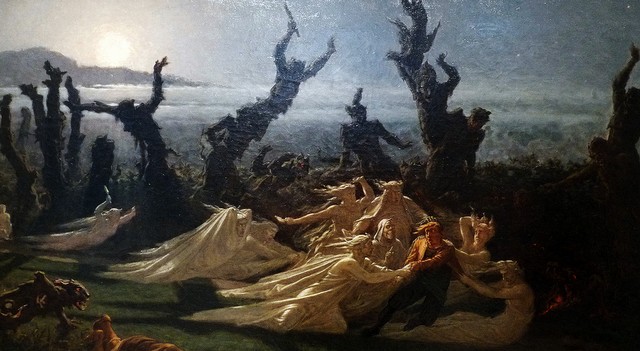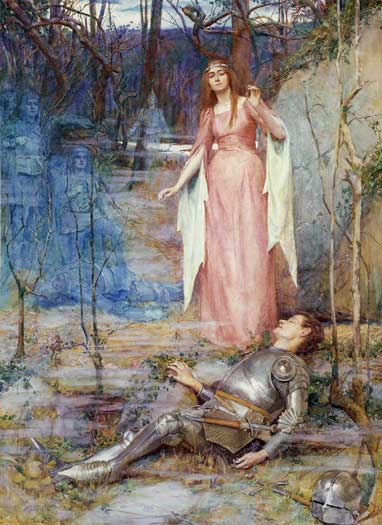 |
| Banshee by Jana Heidersdorf, Germany 1993 |
One of the most mysterious figures in the annals of folklore is the Banshee, stemming out of Scottish and Irish lore, a dark feminine figure who comes with a warning, a promise that mortal death is near. As Death collects souls, she is the figure who announces his travel. She is most notably depicted with long streaming hair and a dark cloak. She is known for her incessant weeping as she releases continual tears from her fiery red eyes.
 |
| Jana Heidersdorf, Germany |
[The Banshee (from ban [
bean], a woman, and
shee [sidhe], a fairy) is an attendant fairy that follows the old families, and none but them, and wails before a death. Many have seen her as she goes wailing and clapping her hands. The keen [
caoine], the funeral cry of peasantry, is said to be an imitation of her cry. When more than one banshee is present, and they will wail and sing in chorus, it is for the death of some holy or great one. An omen that sometimes accompanies the banshee is the
coach-a-bower [
cóiste-bodhar]---an immense black coach, mounted by a coffin, and drawn by headless horses driven by a
Dullahan. It will go rumbling to your door, and if you open it, according to Croker, a basin of blood will be thrown in your face. --- W. B. Yeats, Irish Fairy & Folk Tales
 |
| http://fantasycreatureencyclopedia.blogspot.com |
'The mourning of the deceased is not just the affair of surviving relatives in Ireland. In years past, the measure of a person's respect and stature in the community could be seen in the number of mourners at a funeral and the breadth of their grieving. Professional women keeners, often old women, were paid in drink to weep at the graveside of eminent figures in the community. The Church frowned upon the entanglement of these often alcoholic women and their funerary services, perhaps giving rise to another theory that banshees are the ghosts of professional keeners doomed to unrest as a result of their insincere grieving. Interestingly, this does touch on a basic component of the banshee legend: that banshees follow certain families. If banshees are the ghosts of deceased keeners, their accompaniment is probably due more to a sense of loyalty than a sense of guilt.'--- C. Austin, The Banshee, Celtic Death Messenger
 |
| A Hateful Banshee on a Windy Night by H.R. Heaton |
According to Irish legend the banshee can only cry for a few major families, the O'Briens, the O'Neills, O'Connors, O'Gradys, O'Donnells and Kavanaghs. Intermarriage has since extended this list. Documented superstitions follow families even into Colonial America. Sightings have been reported allegedly even as of 1948. The most prevalent American tales see the banshee traveling to to the likes of Tar River in Edgecombe County, North Carolina. Legend has it that she can still be seen and heard on a hill in the badlands of South Dakota near Watch Dog Butte.
 |
| Banshee, Brian Froud |
The BEAN-NIGHE as she is referred to in Sottish Highlands is comparable to LITTLE-WASHER-BY-THE-FORD (essentially a euphemistic name for the banshee), a figure who is seen at the edge of a river washing the bloodstained clothes of those who are going to die, typically they remain near the water. It is said that if you dare to ask the bean-nighe for who she cries, she will tell you.
 |
| Bean-nighe, Brian Froud 1978 |
'It is said that these spirits are the ghosts of women who died in childbirth and that they are fated to perform their task until the day when they would have normally died.' ---Brian Froud & Alan Lee,
Faeries
 |
| Les Lavandières de la nuit, Yan Dargent, 1861 |
"Women dying in childbed were looked at as dying prematurely, and it was believed that, unless all the clothes left by them were washed, they should have to wash them themselves till the natural period of their death." ---J.G. Campbell,
Superstitions of the Scottish Highlands
 |
| Death, Brian Froud |
Where she stands or sits is really no different and is most likely comparable to a faerie-ring, for once you are in her dwelling you fall under her spell. She can appear in the form of a young maiden adorned in white, wearing a shroud, but more frequently as a wretched old hag with long finger nails and a black veil. And as she disguises herself in various female forms, there is no deception, for once you look into her eyes you will see that she never stops shedding tears. Popular urban tales attribute her as a death deity, perhaps the incessant cries are for the too soon departed. Although it is easy to wrap this figure up as a ghost or a demon, she is none of the sort.
Bean-si refers to a female dweller of a fairy mound. Her Scottish counterpart
bean-shídh in deeper esoteric culture is also known as
aos si, spirits or
ancestors of nature and the survivals of pre Christian Gaelic Dieties.
 |
| La Belle Dame sans Merci, Henry Meynell Rheam 1897 |
Source Materials:
- Irish Fairy & Folk Tales, W. B. Yeats, Dorset Press 1986, New York
- Tales of the Banshee, Patrick F. Byrne, Litho Press 1987, Midleton Co. Cork
- An Encyclopedia of Fairies, Katherine Briggs, Pantheon Books 1976, NY
- Good Faeries & Bad Faeries, Brian Froud, Simon & Schuster 1998, New York, NY
- Faeries, Brian Froud and Alan Lee, Abrams 1978, NY
- www.irelandseye.com
- merganser.math.gvsu.edu
- www.yourirish.com
- fantasycreatureencyclopedia.blogspot.com
- wikipedia.com
- pinterest.com









No comments:
Post a Comment